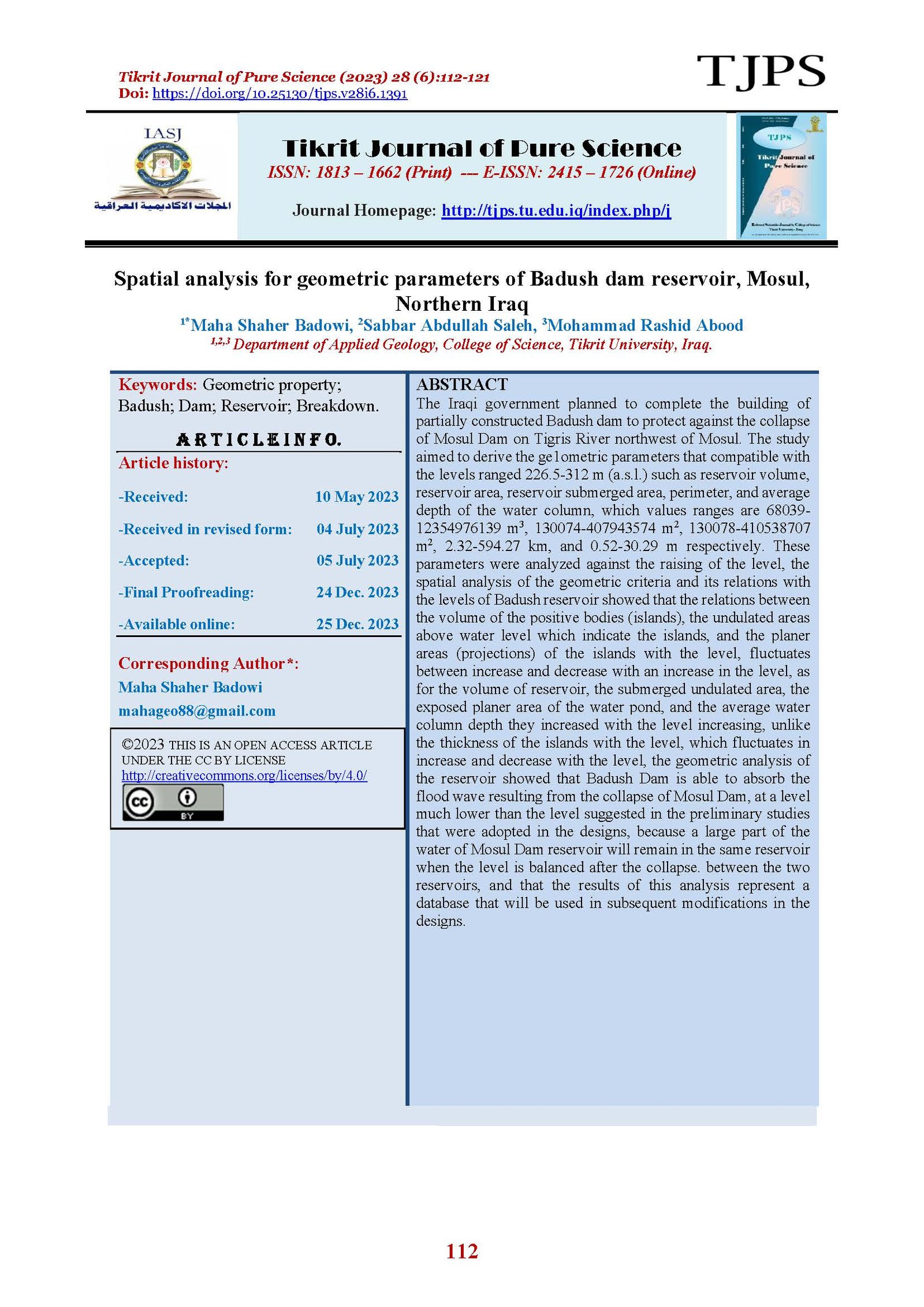Spatial Analysis for Geometric Parameters of Badush dam Reservoir, Mosul, Northern Iraq
Main Article Content
Abstract
The Iraqi government planned to complete the building of partially constructed Badush dam to protect against the collapse of Mosul Dam on Tigris River northwest of Mosul. The study aimed to derive the geometric parameters that compatible with the levels ranged 226.5-312 m (a.s.l.) such as reservoir volume, reservoir area, reservoir submerged area, perimeter, and average depth of the water column, which values ranges are 68039-12354976139 m3, 130074-407943574 m2, 130078-410538707 m2, 2.32-594.27 km, and 0.52-30.29 m respectively. These parameters were analyzed against the raising of the level, the spatial analysis of the geometric criteria and its relations with the levels of Badush reservoir showed that the relations between the volume of the positive bodies (islands), the undulated areas above water level which indicate the islands, and the planer areas (projections) of the islands with the level, fluctuates between increase and decrease with an increase in the level, as for the volume of reservoir, the submerged undulated area, the exposed planer area of the water pond, and the average water column depth they increased with the level increasing, unlike the thickness of the islands with the level, which fluctuates in increase and decrease with the level, the geometric analysis of the reservoir showed that Badush Dam is able to absorb the flood wave resulting from the collapse of Mosul Dam, at a level much lower than the level suggested in the preliminary studies that were adopted in the designs, because a large part of the water of Mosul Dam reservoir will remain in the same reservoir when the level is balanced after the collapse. between the two reservoirs, and that the results of this analysis represent a database that will be used in subsequent modifications in the designs.
Article Details

This work is licensed under a Creative Commons Attribution 4.0 International License.
Tikrit Journal of Pure Science is licensed under the Creative Commons Attribution 4.0 International License, which allows users to copy, create extracts, abstracts, and new works from the article, alter and revise the article, and make commercial use of the article (including reuse and/or resale of the article by commercial entities), provided the user gives appropriate credit (with a link to the formal publication through the relevant DOI), provides a link to the license, indicates if changes were made, and the licensor is not represented as endorsing the use made of the work. The authors hold the copyright for their published work on the Tikrit J. Pure Sci. website, while Tikrit J. Pure Sci. is responsible for appreciate citation of their work, which is released under CC-BY-4.0, enabling the unrestricted use, distribution, and reproduction of an article in any medium, provided that the original work is properly cited.
References
[1] Saleh, S.A., Ali, B.R. and Ahmed, M.A. (2021) Study of Geometric Parameters for the Proposed Protecting Dam Reservoir in Al-Fat'ha Area, Iraq, E3S Web of Conferences, 2nd International Conference on Geotechnical Engineering – Iraq (ICGE 2021), 318, 01009, pp.1-13. https://doi.org/10.1051/e3sconf/202131801009.
[2] Bellen, W. A. et al. (1959) Laxique Stratigraphy International Asia Fascicule 10 a – Iraq, Center National Dela Researches Scientifics. Paris.
[3] Ctyroky, P. and Karim, S. A. (1971) ‘Stratigraphy and Paleontology of the Oligocene and Miocene strata near Anah, Euphrates Valley. NIMCO Report No. CZ 140, SOM’, Library, Baghdad.
[4] Sissakian, V. et al. (2018) Geological and Geotechnical Study of Badush Dam, Iraq,
[5] Ministry of water Resources (2008) Badush dam project, internal report.
[6] Jassim, S. Z. and Goff, J. C. (2006) Geology of Iraq. DOLIN, sro, distributed by Geological Society of London.
[7] AL-Daghastani, H. S. and Ghanem, B. G. (2018) Comparison Between Visual and Digital Interpretation of Lineament Features in Allan Anticline Northern Iraq, Iraqi National Journal of Geosciences, 18(1), pp.1-18.
[8] Tahershamsi, A., Hooshyaripor, F. and Razi, S. (2018) Reservoir’s geometry impact of three dimensions on peak discharge of dam-failure ash ood, Scientia Iranica, 4(25), pp.1-12.
[9] Albayati, B. A. R. A. (2019) Geological and geometric study of the proposed aperture dam reservoir as a blocking dam for the proposed Makhoul dam, Al Fateh area north of Baiji. University of Tikrit.
[10] Saleh, L. M. (2014) Makhoul Reservoir Dam Hydro geometric study of select the optimum level. Ph.D. Thesis, Tikrit University, Iraq.
[11] Nida, G.Sh. Saleh, S.A. (2017) Flood Routing of Tigris River in Baiji Station and Makhoul Dam Reservoir under Supposed Operation of the Dam, Tikrit Journal of Pure Science, 22(1), pp.115-127.
[12] Saleh, S.A., Abdul Qadir, I.T., Ibrahim, A.M. and Hussain, H.M., (2018) Geometric Investigation of Al-Wind Dam Reservoir Northeastern Iraq, using Digital Elevation Models and Spatial Analyses System. Tikrit Journal of Pure Science, 23(3), pp.75-86. https://doi.org/10.25130/tjps.v23i3.503.
[13] Abdula, N., Omary, F., and Al-Kaisy, S. (2022) Analysis of immersed geological formations for Bekhmeh dam reservoir/ Erbil. Tikrit Journal of Pure Science. 27, pp. 50-76. https://doi.org/10.25130/tjps.v27i1.82.
